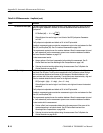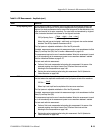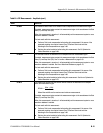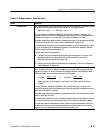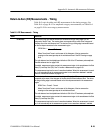
Appendix B: Automatic Measurements Reference
B-24
CSA8000B & TDS8000B User Manual
Table B- 4: RZ Measurements - Amplitude (cont.)
Name Definition
RZ Q Factor A figure of merit of an eye diagram, reporting the ratio between the amplitude of the RZ pulse to
the total RMS noi se on the High and Low levels. The RZ pulse is sampled within the Eye
Aperture, where the High and Low levels are determined as the mean of the histogram of the
data distribution in the upper and lower hal f of the pulse, respectively. The noise levels are
characterized by σhigh and σlow, the standard deviations from the mean for the High and Low
levels.
Where:
H High and Low are the logical 1 and 0 levels.
H σhigh and σlow are the standard deviations.
The Eye Aperture is adj ustable and defaults to 5% of the RZ pulse width. See RZ Eye Aperture
Parameters on B--62.
If enabled, measurement gates constrain the measurement region to the area between the Start
Gate (G1) and Stop Gate (G2). See To Localize a Measurement on page 3--83.
This measurement requires the use of a waveform database. When this measurement is turned
on, it will automat ically set the measurement system to use a waveform database if available.
See Use a Waveform Database on page B--70.
For best result s with t his measurement:
H Perform a Dark Level compensati on before taki ng this m easurement if the source of the
measured waveform is an optical channel. See To Perform Dark-Level and User
Wavelength Gain Compensations on page 3--98.
H Optimize the vertical resolution before taking this measurement. See How to Optimize the
Vertical Resolution on page B--70.
RZ Q Factor =
(High − Low)
(σhigh + σlow)
RZ RMS The true root mean square of the waveform that is sampled within the measurement region.
If enabled, measurement gates constrain the measurement region to the area between the Start
Gate (G1) and Stop Gate (G2).
When this measurement is turned on, it will automatically set the measurement system to use a
waveform database if available.
For best result s with t his measurement:
H Perform a Dark Level compensati on before taki ng this m easurement if the source of the
measured waveform is an optical channel. See To Perform Dark-Level and User
Wavelength Gain Compensations on page 3--98.
H Optimize the vertical resolution before taking this measurement. See To Optimize the
Vertical Resolution on page B--69.





